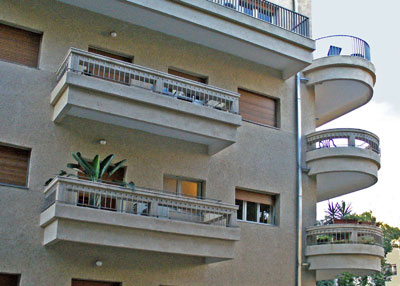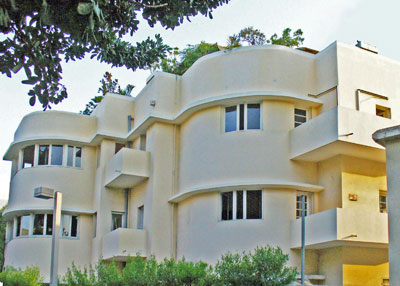Tel Aviv’s Bauhaus architecture
Having just arrived at Ben Gurion International Airport outside Tel Aviv, Israel, I found that I had an afternoon at leisure before rushing off to see such ancient sites as Capernaum, Qumran and Masada with General Tours, Nov. 4-11, 2008. Fortunately, I had an Eyewitness Travel guide to “Jerusalem and the Holy Land” that mentioned Tel Aviv’s so-called “White City,” designated a UNESCO World Cultural Heritage Site in 2003.
Tel Aviv is reputed to have over 4,000 buildings in the New Bauhaus, or International Style, built by immigrant architects from Europe during the 1930s and ’40s. The Bauhaus, for which the style is named, was the architecture, art and design school in Germany from 1919 to 1933 led by such notable founders of the Modernist movement as Walter Gropius.
The style’s emphasis on simplicity and functionality was considered appropriate for the socialist ideals of the Zionist movement, which gave rise to the founding of the new city of Tel Aviv. Characteristics of the style included plain, unadorned and asymetrical façades of white stucco with ribbons of horizontal strip windows, while vertical windows lighted the stairwells.
Wandering from my highrise hotel located on the waterfront of the Mediterranean, I found the largest concentration of Bauhaus buildings on Rothschild Boulevard and neighboring Ha’am Street.
I never did find the Bauhaus Center (99 Dizengoff St.; www.bauhaus-center.com), where I would have found books, souvenirs and information relating to Bauhaus architecture. I learned later that the center runs 2-hour English-language tours at 10 a.m. every Friday ($15) and also has self-guided audio tours ($15).
Fortunately, I found a book while in Jerusalem, “Bauhaus Tel Aviv — An Architectural Guide” by Nahoum Cohen, with photographs by Jachin Hirsch (2003, Batsford, London. 276 pp.). It is listed at www.anovabooks.com for £12.75.
Wear comfortable shoes for lots of walking, and be prepared to see many buildings in a sad state of repair. You’ll probably never again see such a huge concentration of Bauhaus architecture.
DAVID J. PATTEN
Saint Petersburg, FL


